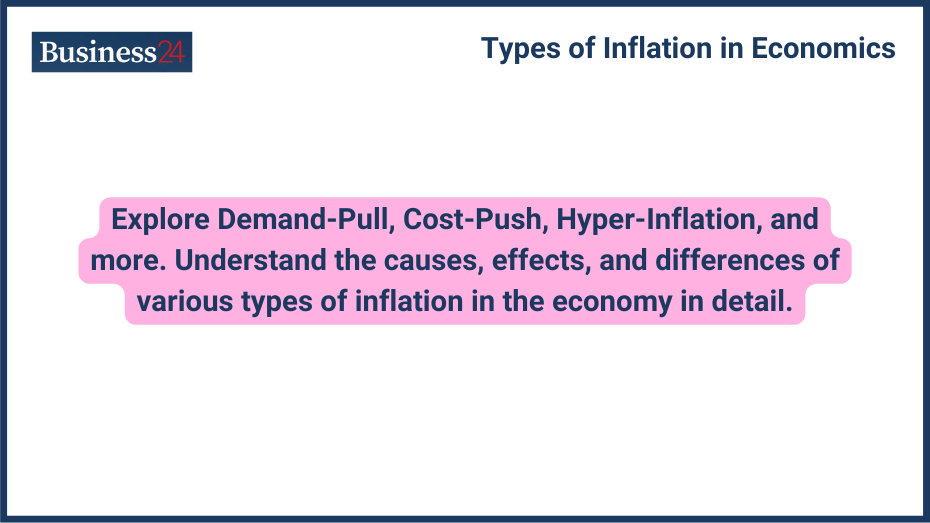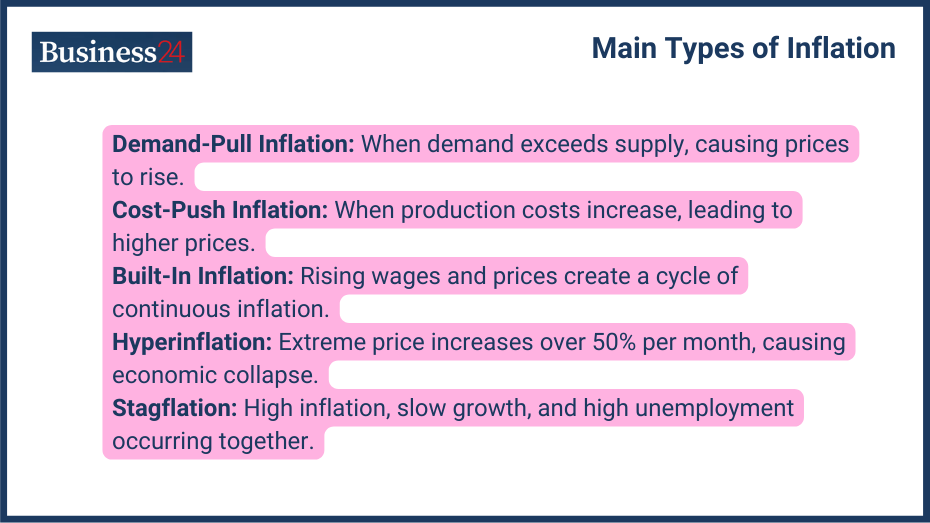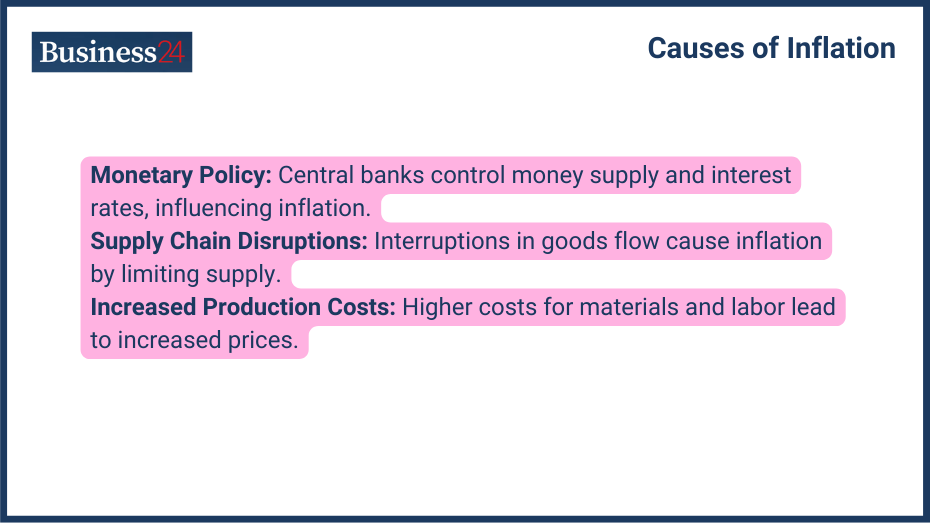
Explore Demand-Pull, Cost-Push, Hyper-Inflation, and more. Understand the causes, effects, and differences of various types of inflation in the economy in detail.
Explore Demand-Pull, Cost-Push, Hyper-Inflation, and more. Understand the causes, effects, and differences of various types of inflation in the economy in detail.
Inflation, also known as a money eater, is an economic reality we all experience. Inflation is the general increase in the prices of goods and services over time. Inflation makes the same amount of money buy you less and less as the years go by. During a high inflation situation, a unit of currency, like a dollar, pound, or euro, gradually loses its purchasing power as prices increase.
Let’s understand inflation by a simple example — In a rising inflation economy year by year, a gallon of milk costs $2.00 today. With inflation, the same gallon of milk might cost $2.10 next year, then $2.21 the year after.
Inflation is measured by indexes like the Consumer Price Index (CPI) and the Producer Price Index (PPI), which track the average price changes of a basket of goods. Both of these indexes have different purposes!! The CPI tracks the average price changes for a basket of essential goods and services that households purchase, like food, transportation, housing, and healthcare. At the same time, the PPI measures the average changes in wholesale prices that producers receive for their goods and services.
What are the Main Types of Inflation?

There are various types of inflation; each has its own characteristics and causes:
- Demand-Pull Inflation: Demand and supply are the basic nature of an economy, and when disbalance occurs, you have to face some disturbances. Whenever the overall demand for goods and services increases due to factors like rising government spending, consumer spending, or a surge in exports, demand-pull inflation rises. When demand outstrips supply, businesses have the ability to raise prices to meet the higher demand, and inflation rises.
- Cost-Push Inflation: Sometimes, due to rising raw material prices such as oil, agricultural products, or high labor costs, the cost of production increases for businesses. Since businesses cannot bear the costs alone, they pass them down to customers, hence increasing prices and leading to inflation.
- Built-In Inflation: Built-in inflation originates from a phenomenon known as the wage-price spiral. As inflation rises to meet expenses, workers demand higher wages to maintain their purchasing power. If the labor costs increase, businesses maintain their profit margin by increasing the product prices. This creates a cycle where rising wages lead to rising prices and vice versa.
- Hyperinflation: Hyperinflation is the most extreme kind of inflation, where prices rise incredibly fast, often over 50% each month. A well-known example is Zimbabwe’s economic collapse in the late 2000s and Germany’s troubles after World War I, where inflation peaked at 79.6 million percent in 2008. Hyperinflation can destroy an economy, making money nearly worthless and resulting in social chaos.
- Stagflation: Stagflation is a unique economic situation where inflation stays high, economic growth slows down or stops, and unemployment remains high. It’s a complex issue with many possible causes, making it tough for policymakers to tackle. The U.S. went through a period of stagflation in the 1970s, marked by high inflation, slow economic growth, and high unemployment.
What are Other Forms of Inflation?
Other forms of inflation are:
- Creeping Inflation: Many developed economies experience some level of creeping inflation over time, typically measuring 1-3% per year. It is a slow and steady rise in prices and is considered manageable and healthy for economic growth as it encourages investment in growing economies.
- Walking Inflation: describes a moderate rate of inflation, usually between 3-10% per year. While it’s not as severe as other types, walking inflation can still reduce purchasing power over time if it’s not controlled. It can create uncertainty for both businesses and consumers as they deal with rising prices.
- Galloping Inflation: When inflation rises rapidly over 10% annually, sometimes reaching double or triple digits, it is known as Galloping inflation. Galloping inflation is very bad for an economy, causing high price swings and difficulties for individuals and businesses. Galloping inflation occurs due to rapid economic changes, such as currency devaluation or war.
What are the Causes of Inflation?

There are different causes of inflation, such as major events like wars, financial crises, internal conflicts, etc. Here are some of the main causes of inflation:
- Monetary Policy: The central bank of any country is responsible for managing the money supply and interest rates. These parameters play a significant role in inflation. If a central bank prints more money and injects it into an economy, it can increase in the money supply relative to the available goods and services. This can trigger demand-pull inflation as more money chases after a limited supply of goods and services, driving prices up. There are various other monetary policies that are directly or indirectly responsible for controlling or increasing inflation in a country.
- Supply Chain Disruptions: Another major cause of inflation is supply chain disruptions, which affect the smooth flow of goods and services from producers to consumers and can lead to cost-push inflation. When disruptions occur in the chain, inflation rises due to a lack of supply of goods, which increases inflation. There are various reasons for supply chain disruptions, such as natural disasters like hurricanes or floods that damage infrastructure and hinder production or transportation. One of the major examples recently is the COVID-19 pandemic, which impacted the whole global supply chain.
- Increased Production Costs: When the cost of running a business goes up, like the price of raw materials, labor, or energy, it can lead to cost-push inflation. This often happens due to factors like global commodity prices going up, increases in the minimum wage, or higher taxes on businesses. To keep their profits steady, businesses might then raise their prices, which affects consumers by making goods and services more expensive.
How Does Inflation Impact the Economy?
Yes, inflation impacts the economy in various ways. From the common man to big businesses, everyone can suffer due to high inflation.
- Purchasing Power: The rise in inflation and reduced purchasing power most affect middle-class or lower-earning class people. As the general level of prices rises, the value of a unit of currency like a dollar decreases. For example, if inflation is at 5%, a $100 grocery bill today will cost $105 next year. This can strain household budgets and spending habits.
- Interest Rates: Central banks use interest rates to control inflation. When inflation goes up, they increase interest rates to make borrowing and spending less attractive. This helps slow down the economy and curb inflation. However, higher interest rates can also make it more expensive for businesses and consumers to borrow money, which can affect investment and economic growth.
- Wages: Due to high living costs, workers might demand higher wages. This is an additional cost for a business, and businesses compensate for it by increasing the price of goods and services.
- Economic Growth: A little bit of inflation can actually be good for the economy because it encourages people to spend and invest. However, when inflation gets too high, it hurts economic growth. Businesses hold back on investing because they’re unsure about future prices, and consumers delay buying things because costs are going up. High inflation also makes it tough for businesses to plan and manage their budgets.
- Uncertainty and Risk: Businesses and consumers find it hard to plan for the future because prices keep changing unpredictably. This uncertainty results in less investment and slower economic activity.
Disclaimer
eToro is a multi-asset platform which offers both investing in stocks and cryptoassets, as well as trading CFDs.
Please note that CFDs are complex instruments and come with a high risk of losing money rapidly due to leverage. 51% of retail investor accounts lose money when trading CFDs with this provider. You should consider whether you understand how CFDs work, and whether you can afford to take the high risk of losing your money
This communication is intended for information and educational purposes only and should not be considered investment advice or investment recommendation. Past performance is not an indication of future results.
Copy Trading does not amount to investment advice. The value of your investments may go up or down. Your capital is at risk.
Don’t invest unless you’re prepared to lose all the money you invest. This is a high-risk investment and you should not expect to be protected if something goes wrong. Take 2 mins to learn more
eToro USA LLC does not offer CFDs and makes no representation and assumes no liability as to the accuracy or completeness of the content of this publication, which has been prepared by our partner utilizing publicly available non-entity specific information about eToro.
